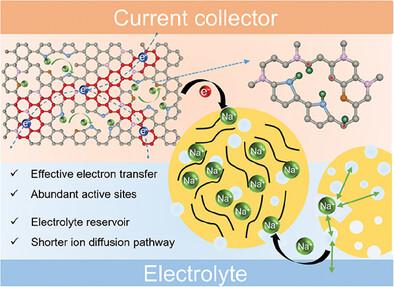当前位置:
X-MOL 学术
›
Adv. Energy Mater.
›
论文详情
Our official English website, www.x-mol.net, welcomes your feedback! (Note: you will need to create a separate account there.)
Modulating Intrinsic Defect Structure of Fibrous Hard Carbon for Super‐Fast and High‐Areal Sodium Energy Storage
Advanced Energy Materials ( IF 27.8 ) Pub Date : 2024-03-22 , DOI: 10.1002/aenm.202400125 Li Yuan 1 , Qianyu Zhang 1 , Yiran Pu 1 , Xiaoling Qiu 1 , Can Liu 1 , Hao Wu 1
Advanced Energy Materials ( IF 27.8 ) Pub Date : 2024-03-22 , DOI: 10.1002/aenm.202400125 Li Yuan 1 , Qianyu Zhang 1 , Yiran Pu 1 , Xiaoling Qiu 1 , Can Liu 1 , Hao Wu 1
Affiliation

|
Creating defects by heteroatom doping is commonly approved in respect of enhancing fast sodium‐ion storage of carbonaceous anodes ascribing to rich external defects, but the contribution of intrinsic carbon defects (e.g., vacancy) in improving rate‐capability has rarely been investigated. Here, a bio‐derived fibrous hard carbon with high‐reversible intrinsic defects is synthesized via metal‐assisted‐catalytic strategy. It is found that sp2 ‐hybridized carbon is united through catalytic‐tuning during thermal‐etching process along with the formation of low‐potential planar intrinsic carbon defects (vacancies and non‐hexagonal carbon rings) by sacrificing poor‐reversible carbon edges. Such integrated structures greatly improve the reversibility of defective sites and charge transfer kinetics, thus enhancing the slope sodium‐storage capacity of carbon below 1 V even at high current densities. Thus‐obtained fibrous carbon anodes enable boosted initial coulombic efficiency (≈90%) and ultrahigh‐rate capability in both half‐ (222.2 mAh g−1 at 50 A g−1 ) and full‐cell (200 C, charged/discharged in ≈10 s). Interestingly, compared with meso‐/macroporous structures, such micropore‐dominated carbon fibers are more beneficial for fabricating high‐mass‐loading, crack‐free thick electrodes (>10 mg cm−2 ) with considerable areal‐capacity over 3.0 mAh cm−2 . Paired with high‐loading Na3 V2 PO4 cathode (14.4 mg cm−2 ), full‐cell achieves admirable areal‐capacity over 1.4 mAh cm−2 and peak areal‐energy/power‐density of 3.2/74 mW cm−2 .
中文翻译:

调节纤维硬碳的固有缺陷结构用于超快速和大面积钠储能
由于丰富的外部缺陷,通过杂原子掺杂产生缺陷通常被认为可以增强碳质阳极的快速钠离子存储,但内在碳缺陷(例如空位)在提高倍率性能方面的贡献却很少被研究。在这里,通过金属辅助催化策略合成了具有高可逆固有缺陷的生物衍生纤维硬碳。发现sp2 ‐杂化碳通过热蚀刻过程中的催化调节结合在一起,并通过牺牲可逆性较差的碳边缘形成低电位平面固有碳缺陷(空位和非六边形碳环)。这种集成结构极大地提高了缺陷位点的可逆性和电荷转移动力学,从而即使在高电流密度下也将碳的斜率钠存储能力提高到1V以下。由此获得的纤维碳阳极能够提高初始库仑效率(约 90%)和半高倍率能力(222.2 mAh g−1 50 A g 时−1 )和全电池(200 C,充电/放电时间约 10 秒)。有趣的是,与介孔/大孔结构相比,这种以微孔为主的碳纤维更有利于制造高质量负载、无裂纹的厚电极(>10 mg cm−2 )具有超过3.0 mAh cm的相当大的面积容量−2 。与高负载Na配对3 V2 采购订单4 阴极(14.4 mg cm−2 ),全电池实现了超过 1.4 mAh cm 的令人惊叹的面积容量−2 峰值面积能量/功率密度为 3.2/74 mW cm−2 。
更新日期:2024-03-22
中文翻译:

调节纤维硬碳的固有缺陷结构用于超快速和大面积钠储能
由于丰富的外部缺陷,通过杂原子掺杂产生缺陷通常被认为可以增强碳质阳极的快速钠离子存储,但内在碳缺陷(例如空位)在提高倍率性能方面的贡献却很少被研究。在这里,通过金属辅助催化策略合成了具有高可逆固有缺陷的生物衍生纤维硬碳。发现sp



























 京公网安备 11010802027423号
京公网安备 11010802027423号